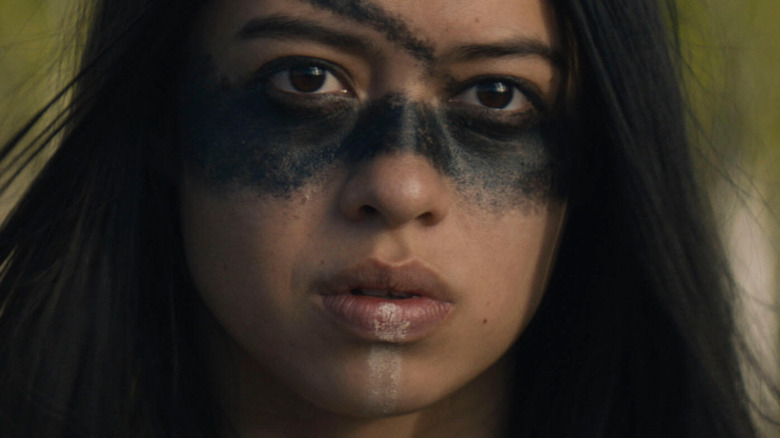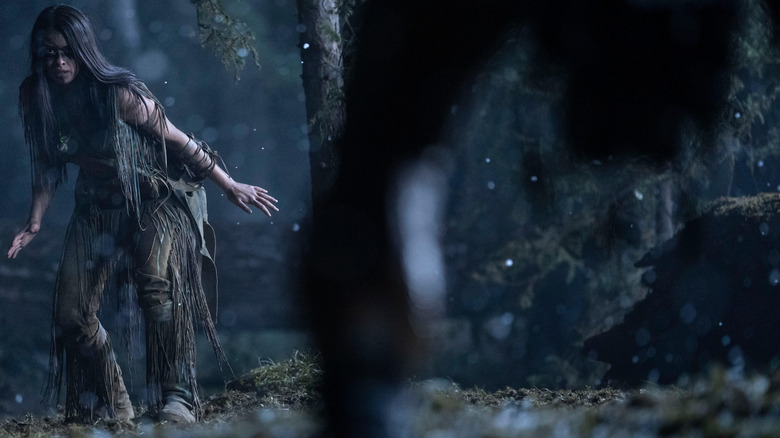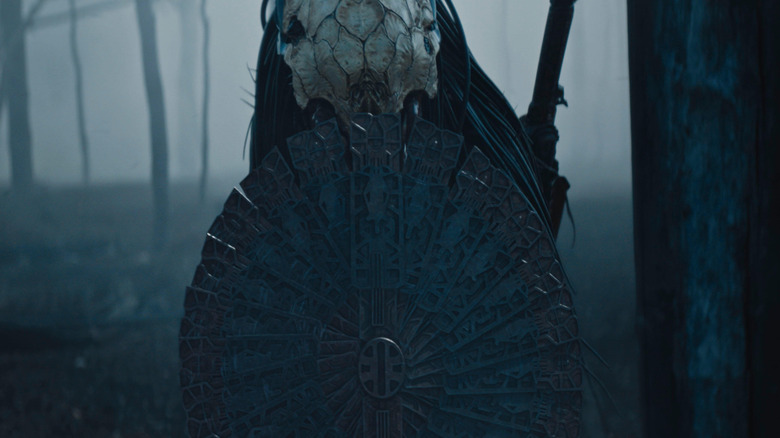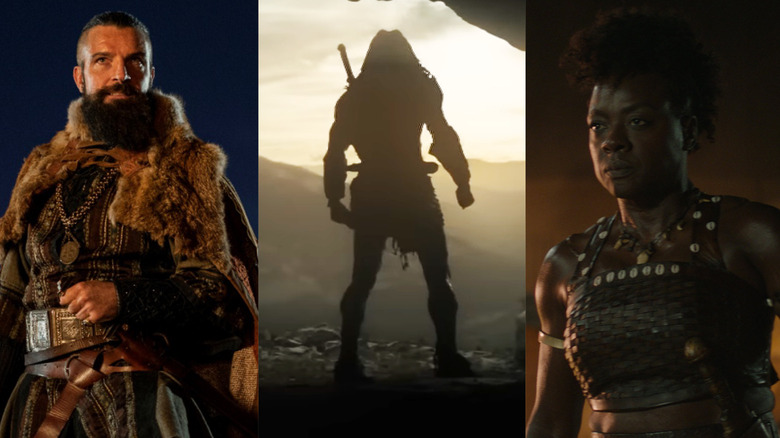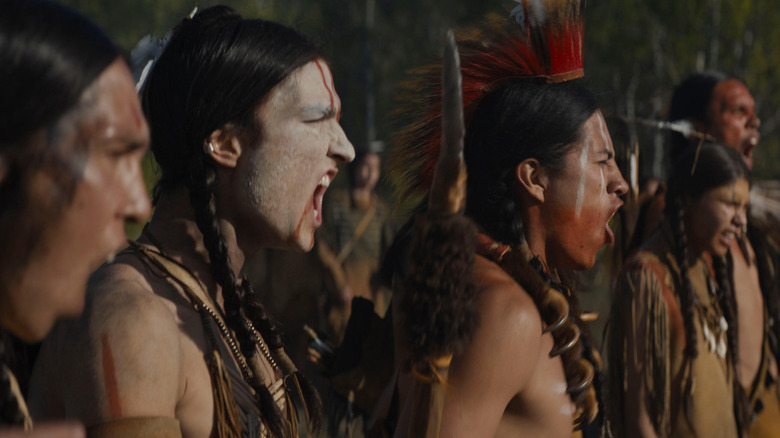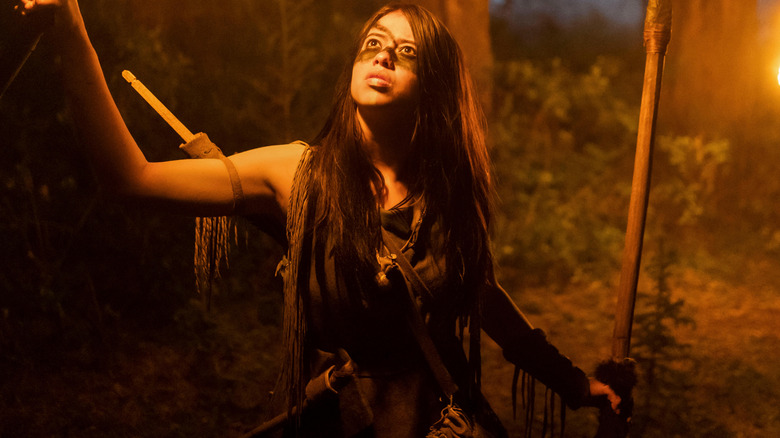Here's How Prey Fixed So Many Of The Problems With The Recent Predator Films
Contains spoilers for "Prey"
When it was released in 2018, Shane Black's "The Predator" felt like the final critical hit to a franchise that had been bleeding out for years. Now, the director of "10 Cloverfield Lane," Dan Trachtenberg, has picked up the scent of the iconic alien hunter and is going back a few hundred years with "Prey." The new film sees Comanche warrior Naru (Amber Midthunder) square off with our favorite space invader to protect her home and obtain honor within her tribe. Thankfully, early reactions and critical responses came in droves, confirming that "Prey" isn't just a great watch, but the best entry to the franchise since we first laid eyes on that ugly mother ... well, you know.
Avoiding the traps that so many big prequels have been caught in over the years, "Prey" sends us on a very different trail than do the previous films and is all the better for it. But just what has Trachtenberg packed in his hunting gear to deliver a movie worthy of being at the top of this beloved film series' food chain? Well, here are just a few things that might give "Prey" the edge over its predecessors and help it bring the heat back to a franchise that had seemingly gone stone-cold.
Prey wastes no time hunting out what makes a Predator movie great
In 1987, John McTiernan's "Predator" did something no other action movie had prior — it made you genuinely scared for the safety of Arnold Schwarzenegger. After unloading classic one-liners and enough bullets to fill a "John Wick" movie, "Predator" switched things up. The Austrian Oak who had made a career of being indestructible became anything but, fighting to survive as the lone soldier, Dutch, in an almost dialogue-free finale that had the role of "hunter" and "hunted" changing on a dime. The thrill of the chase between a lone human and a technologically advanced beast was the film's biggest highlight when it got down to basics, but it was a plot beat that became stale in the franchise entries that followed.
Excluding Nimród Antal's underappreciated "Predators," too much time was spent on each film's trophies-to-be trying to figure out what they were getting tracked by. Dan Trachtenberg's blood-soaked session avoids that mistake, instead giving the dreadlocked death-dealer a worthy opponent in the form of Comanche tracker Naru, who quickly concludes that something else besides her tribe is out hunting. Doing so allows unwanted fat to be skinned fairly early on, letting the film cut to the chase that fans are keen to see between two primarily lone hunters, just like before. It's a clear indicator that time is unquestionably on Trachtenberg's side, including when it comes to the film's setting, which resets the history of the Predator in all the best ways.
What's old is refreshingly new for the Predator in Prey
As much as we tried to forget it, a flimsy thousand-year-old flashback in "Alien vs. Predator" showed the titular trophy seekers building pyramids. The issue is that they are as tooled up then as they are when they encounter Dutch in the 1987 film, begging the question of if there was ever a challenge in their routine safari trips. Thankfully, Dan Trachtenberg and debut film scribe Patrick Aison retcon that smudge in the history books for a less developed Predator, which in turn gives "Prey" an unexpected upgrade.
The space hunter with Naru in its sights is a clear ancestor of the ones we're used to, mandibles and all. Brandishing headgear that looks to be made from the skins of its former kills rather than that unmistakable faceplate establishes a technological timeline for the alien race. Doing so tightens the gap between both sides, still certifying the Predator as a threat but one more likely to bleed thanks to its low-tech arsenal. Trachtenberg told Collider, "It was very tricky to find a way to have the Predator feel, at once, 300 years earlier in iteration and in what it has to wield, but also feel [sic] still feel far more advanced than what our characters are used to and have ever dealt with before." It's a successful idea, not only creating an exciting take on the creature but also demonstrating that the potential success of the franchise's future might be in its past.
Prey's trip through time has saved the Predator franchise and opened up years of opportunity
"Prey" has managed to revive the franchise to its former glory by putting the legendary bone collector in an era we've never seen it in before. It's a game-changing choice that proves the hunted hero doesn't necessarily have to have modern-day firepower before taking on a monster known for having massive rage quits. It also ensures that adding an installment to the franchise set in a time outside our own opens up other historical possibilities for the Predator to "stick around" in.
"Prey" chronicles the oldest-known hunt of the franchise's violent visitors, but it doesn't mean it was the first. How might the iconic aliens have handled samurai warriors in feudal Japan or the Dahomey army of West Africa soon to be highlighted in "The Woman King"? Did this race that thrives in the heat of battle go up against Vikings? If not, in Odin's name, why not? Should such an approach be taken, it would be great to see any follow-up film have the same attention to detail as "Prey," one that could focus on a culture that until now has been given skewed or little representation in mainstream media setting up an all the more compelling story because of it.
Prey's cultural authenticity breaks new ground for the franchise and the film industry
For all their perks, the previous "Predator" installments haven't done much in reinventing the serrated smart disc after Dutch's 1987 scuffle. "Prey" thankfully changes that by giving us a new take on an old foe and dropping it into a story comprised predominantly of Native American stars, including its lead. The creative choice spawned from the image of Sonny Landham's Billy, Dutch's Native American scout, and his last stand in the 1987 film. Thirty-five years later, it still resonated with Dan Trachtenberg, who told Empire (via AvP Galaxy) that he was determined to see "someone lead this movie that has never led this type of movie before."
To ensure such a crucial part of the film was carefully handled, Comanche and Blackfeet American Indian producer Jhane Meyers joined the project, operating as the film's cultural advisor. Her input changed a potential franchise money-spinner into one of the most intriguing installments to the "Predator" franchise to date — both versions, that is. A Comanche-language cut will also be available to stream upon release, marking a first in the series and a rarity for films as a whole. Besides providing much-needed inclusivity, doing so will give "Prey" a totally different viewing experience that this franchise and others could benefit from. The only real struggle they will have is having it center on a lead as compelling as this one.
Prey's Amber Midthunder just became the franchise's apex predator
Whenever these spine-snatching stalkers have visited Earth on-screen, women have often been the least of their worries. With Elpidia Carrillo's Anna from the original film not being deemed a threat and Maria Conchita Alonso's Leona getting passed over for the sake of her unborn baby in "Predator 2," it was left to the tough men of Hollywood to put the Yautja in check.
"Prey" finally breaks those dated hunting traditions in the best ways possible, thanks to not only one of the best performances in the franchise but also one that fleshes out a character at the core of a story worth investing in. Whereas the previous films were about fighting for survival against an invisible threat, "Prey" focuses on a hero determined to prove herself even before that iconic tri-laser gets fired up.
Naru wants to be respected in her tribe, so much so that she's willing to go up against a grizzly bear-disposing monster from the skies to get it. The safety of her people is an understandable concern, but seeing her fight for her self-worth is an added element that puts "Prey" on a different playing field than the other "Predator" films, and it's thanks to Amber Midthunder that it works so well. Even if 20th Century Studios doesn't take the approach of having Vikings or samurais throw down with Predators in the future, there's a brave Comanche warrior we'd be happy to see in a rematch.
